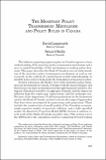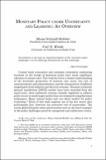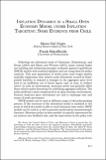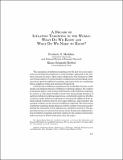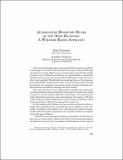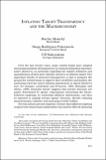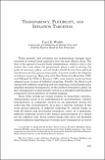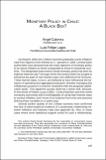Buscar
Mostrando ítems 1-10 de 13
The monetary policy transmission mechanism and policy rules in Canada
The inflation targeting regime in place in Canada requires a clear understanding of the monetary policy transmission mechanism and a way to exploit knowledge of that mechanism in making policy decisions. This paper describes the Bank of Canada's current undestanding of the monetary policy transmission ...
Monetary policy under uncertainty and learning: an overview
Central bank economists and academic economists conducting research on the design of monetary policy have made significant advances in recent years. This work has led to a clearer understanding of the desirable properties of interest rate rules, the role of announcements and communication, and the ...
New frontiers for menetary policy in Chile
Inflation targeting can be broadly defined as a framework for the conduct of MONETARY POLICY in which the central bank guides its instruments in order to hold inflation near a preannounced target or to bring back to the target. Although understanding the framework is straightfoward, its practical ...
Inflation dynamics in a small open economy model under inflation targeting: some evidence from Chile
Following the influential work of Christiano, Eichenbaum, and Evans (2005) and Smets and Wouters (2003), many central banks are building and estimating dynamic stochastic general equilibrium (DSGE) models with nominal rigidities and are using them for policy analysis. This new generation of sticky ...
International aspects of the zero lower bound constraint
Large negative aggregate demand shocks can drive down an economy’s equilibrium real interest rate and if the central bank is committed to stabilizing inflation monetary policy may be hampered by the zero lower bound on nominal interest rates –the economy may be in a 'liquidity trap.' The policy dilemma ...
A decade of inflation targeting in the world: what do we know and what do we need to know?
The emergence of inflation targeting over the last ten years represents an exciting development in central banks' approach to the conduct of monetary policy. After initial adoption by New Zealand in 1990, a growing number of central banks in industrial and emerging economies have opted for inflation ...
Alternative monetary rules in the open-economy: a welfare-based approach
How do central banks choose among alternative monetary polocies? In this paper we analyze that question for an open economy following an interest rate rule. Many issues remain controversial in the design of such a rule. If inflation is targeted, as it presumably is, should the domestic interest rate ...
Inflation target transparency and the macroeconomy
Over the last twenty years, many central banks have adopted increasing standards of transparency in communicating their monetary policy objectives, in particular regarding the explicit definition and quantification of their price stability objective or inflation target. One important benefit of increased ...
Transparency, flexibility, and inflation targeting
Three parallel and certainly not independent changes have occurred in central bank practices over the past fifteen years. The first is the spread of central bank independence, which is tied to the notion that even when the government plays a role in setting the goals of monetary policy, central banks ...
Monetary policy in Chile: a black box?
During the 1990s the Chilean economy gradually cut its inflation rate from figures in the thirties to 4.7 percent in 1998. Central bank authorities have declared that the main objective of monetary policy is to reduce inflation to levels comparableto those in industrial countries. The desgnated ...

